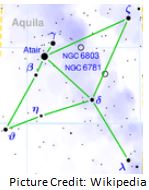Aquila, the Eagle is a fairly easy constellation to
identify. Along with last month's constellation
of the month, Lyra, and the October 2012 constellation of the month, Cygnus,
Aquila's brightest star, Altair makes up the large and prominent Summer Triangle of stars. Aquila is the southernmost of these three constellations.
Aquila's immediate neighbors are small and rather faint constellations, such as Delphinus, Scutum, Vulpecula, Sagitta, Capricornus, and Equuleus. The tail of Serpens points to Aquila from the East.
The band
of the Milky Way passes through Aquila on the way from Cygnus
to the North and Sagittarius
to the South. When we look at the band
of the Milky Way, we are looking along the plane of our disc-shaped
galaxy. As a result, we see many more
starts than if we look above or below the plane. We would also expect there to be many more nebulae
and star clusters, but those in the line of sight of Aquila are relatively
faint.
Coincidentally, there are very few galaxies to be
found looking in the direction of Aquila.
So, there are no Messier objects in Aquila. The French astronomer Charles Messier
cataloged a list of 110 hazy objects in the sky. He was trying to identify these objects -- which appeared to stay in the same place -- in order to distinguish them from moving comets, for which he was
searching. The objects he cataloged turned
out to be nebulae (clouds of gases) in our galaxy and distant galaxies themselves. But nothing in
Aquila makes this Top 110.





1 comment:
I am grieving, for many reasons, one of which has compelled me to reflect with public words.executive sober living ny
Post a Comment